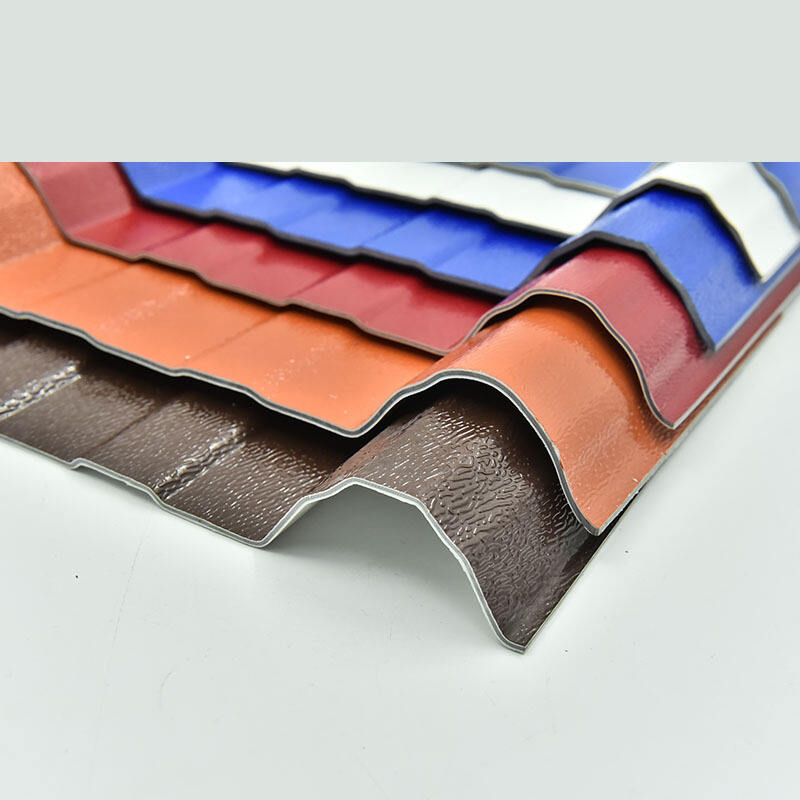How to Choose the Right PVC Roof Sheet for Your Building Project
Key Factors to Consider When Choosing a PVC Roof Sheet
When choosing a PVC roof sheet for your building project, the architectural design and specific type of roof must be assessed to ensure compatibility with various PVC roof profiles. Different designs may require different profiles, such as corrugated or flat sheets, to ensure both aesthetic appeal and functional effectiveness.
Energy efficiency is another crucial factor to consider. PVC roof sheets with high energy efficiency ratings can offer excellent insulation properties and reflect sunlight, potentially reducing cooling costs significantly—up to 20% in some cases. Investing in energy-efficient PVC roofing can thus lead to substantial savings over time.
Researching the expected durability and lifespan of PVC materials is essential, as high-quality sheets can last over 30 years. This longevity makes them a reliable long-term roofing solution. By selecting durable materials, building owners can minimize the frequency of replacements and repairs, thereby saving on costs in the long run.
Additionally, evaluate the maintenance requirements of PVC roof sheets. These materials typically require less cleaning and inspections compared to traditional roofing materials. The lower maintenance demand means less frequent service interruptions and cost savings over the lifetime of the roof. Understanding these varying factors in the context of your building needs helps ensure the best choice in PVC roofing.
Benefits of PVC Roof Sheets for Building Projects
PVC roof sheets present numerous benefits for building projects, primarily due to their impressive weather resistance and waterproofing capabilities. These materials are designed to withstand severe weather conditions without compromising structural integrity, making them a reliable choice for areas prone to heavy rainfall or extreme weather. This robust nature not only enhances the durability of the roofs but also mitigates the risk of leaks and water damage, which can be costly to repair.
Furthermore, PVC roof sheets are highly regarded for their exceptional chemical and fire resistance. The inherent properties of PVC make it less susceptible to damage from chemical exposure, which is particularly useful in industrial settings. Additionally, the fire-resistant quality of these sheets adds an extra layer of safety, reducing potential risks and ensuring compliance with building safety standards.
Another notable advantage of PVC roof sheets is their lightweight nature. Unlike more traditional roofing materials, PVC sheets are easier and faster to install, significantly reducing labor costs and installation time. This property not only expedites roofing projects but also makes it feasible to work with complex architectural designs that might otherwise be limited by heavier materials.
Cost-effectiveness is another critical benefit of PVC roof sheets when considered over the long term. The reduced need for maintenance coupled with the energy savings associated with their reflective properties lead to a favorable return on investment. For instance, their ability to reflect sunlight can lower cooling costs, potentially resulting in significant energy bill reductions over the years. By investing in PVC roofing, building owners may find that the initial expenditure is offset by these long-term savings, making them a practical and economical choice.
Top PVC Roof Sheet Products for Your Building Project
1050mm Blue ASA PVC Heat Insulation Plastic Roof Sheets
The 1050mm Blue ASA PVC Heat Insulation Plastic Roof Sheets are engineered for superior thermal efficiency, making them a prime choice in diverse climate conditions. Their distinct blue hue not only enhances aesthetic appeal but also reflects sunlight, significantly reducing heat absorption and promoting energy savings. This reflective capability makes them particularly popular in both residential and commercial building applications. Their robust construction ensures long-lasting performance under extreme weather conditions.
1050mm Green ASA PVC Resin Composite Roof Sheets
The 1050mm Green ASA PVC Resin Composite Roof Sheets offer substantial environmental benefits given their recyclable materials and eco-friendly composition. This unique green hue complements natural landscapes and supports nature-centric design philosophy. Renowned for reliability, these sheets display exceptional performance metrics in various weather conditions, ensuring steadfastness in even the most unpredictable climates. Their robustness and aesthetic appeal make them a favorite in eco-conscious residential and commercial projects.
1050mm Dark Blue Waterproof Heat Resistant ASA UPVC Synthetic Roofing Tiles
The 1050mm Dark Blue ASA UPVC Synthetic Roofing Tiles are exceptionally designed with waterproof and heat-resistant properties, perfect for regions prone to heavy rainfall or extreme temperatures. These tiles are widely used in agricultural buildings where moisture control and temperature stability are crucial. Boasting a durable framework and advantageous warranty options, these roofing tiles ensure a long-lasting investment. Their construction not only addresses specific environmental challenges but also supports sustained structural integrity over time.
Installation Tips for PVC Roof Sheets
Proper placement and alignment are crucial in preventing leaks during the installation of PVC roof sheets. Begin by measuring the roof area accurately and cutting the PVC sheets to size using appropriate tools, ensuring that edges are straight to aid in seamless alignment. This precision minimizes gaps, which are potential leakage points. When laying the sheets, allow for an overlap, usually of one corrugation, to improve water run-off and further decrease the chances of water intrusion.
Using purlin tape is a practical measure to curb noise generated by rain and wind striking the roof surface. Applying this tape on the purlins before fixing the sheets helps dampen vibrations, leading to a quieter indoor environment. This is particularly beneficial for residential and commercial establishments in regions prone to frequent rainfall or strong winds, enhancing comfort for occupants residing or working under these roofs.
Safety is paramount during the installation process of PVC roof sheets. Always wear suitable personal protective equipment (PPE), including gloves, goggles, and safety harnesses, especially when working on heights. Secure handling of the sheets is essential to prevent accidents: their large size and lightweight nature can make them susceptible to wind gusts. Training workers on these safety measures not only safeguards them from injuries but also ensures a smooth installation process, resulting in a durable and resilient roof.
Common Challenges with PVC Roof Sheets and How to Address Them
PVC roof sheets, although durable and efficient, can encounter challenges like water pooling and drainage issues. Water pooling, for instance, arises when the roof surface is not properly sloped, leading to accumulated water. To address this, ensure the installation includes a proper slope and consider specialized drainage systems that facilitate water flow. Regular inspections can help identify and rectify drainage inefficiencies before they become problematic.
Seam welding is a critical technique in preventing leaks in PVC roofing. Properly welded seams create a watertight barrier essential for the roof's longevity. Reputable contractors utilize the latest tools and materials, such as hot-air welding equipment, to enhance seam integrity. These technologies ensure tight seals, reducing the chances of water infiltration even in adverse weather conditions.
Another concern is the temperature sensitivity and shrinkage of PVC, or its relative, UPVC roof tiles. Temperature fluctuations can cause these materials to expand or contract, leading to shrinkage-related issues such as cracking. This can be mitigated by incorporating expansion joints during installation. Adjustments in the installation process to account for temperature variations can significantly reduce the likelihood of these challenges. Regular maintenance checks are also vital to early detection and repair, ensuring the roof remains in optimal condition.
FAQ Section
What are the main benefits of using PVC roof sheets?
PVC roof sheets offer weather resistance, excellent insulation properties, and reflect sunlight to reduce cooling costs. They are also lightweight and easy to install, providing cost-effectiveness over the long term.
How long do PVC roof sheets last?
High-quality PVC roof sheets can last over 30 years, making them a reliable long-term roofing solution.
What maintenance is required for PVC roof sheets?
PVC roof sheets typically require less cleaning and inspection compared to traditional roofing materials, resulting in cost savings and less frequent service interruptions.
How can I prevent leaks during PVC roof sheet installation?
Accurate measurement and cutting, proper alignment, and allowing for overlap during installation are crucial to minimizing leakage risks.
Are there specific challenges with PVC roofing, and how can they be addressed?
Challenges include water pooling and drainage issues, but these can be mitigated by ensuring proper slope during installation and regular inspections. Seam welding is also important to prevent leaks.
The Differences Between UPVC Roof Tiles and ASA Roof Tiles
ALLHow to choose the right roof tile
NextRecommended Products
Hot News
-
How to choose the right roof tile
2024-01-24
-
PVC Plastic Tiles: The Ideal Roofing Material
2024-01-24
-
The Essentials of Synthetic Resin Tile Manufacturing
2024-01-24

 EN
EN
 AR
AR
 BG
BG
 HR
HR
 CS
CS
 DA
DA
 NL
NL
 FI
FI
 FR
FR
 DE
DE
 EL
EL
 HI
HI
 IT
IT
 JA
JA
 KO
KO
 NO
NO
 PL
PL
 PT
PT
 RO
RO
 RU
RU
 ES
ES
 TL
TL
 IW
IW
 ID
ID
 LT
LT
 VI
VI
 TH
TH
 TR
TR
 AF
AF
 MS
MS
 KM
KM
 LO
LO
 MY
MY

.webp)
.webp)
.webp)

